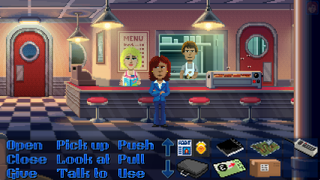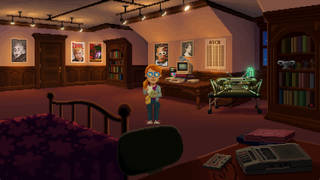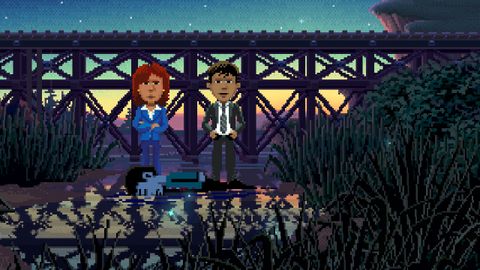GamesRadar+ Verdict
Thimbleweed Park is like the HD remaster of a lost LucasArts adventure from the '80s, with all the hilarious, self-aware dialogue and sometimes frustrating design of the era brought forward into the 21st century.
Pros
- +
Evokes feelings of classic LucasArts adventures at its best
- +
Unconventional pacing keeps the narrative unpredictable
- +
Interesting premise and characters bursting with genuinely funny dialogue
Cons
- -
Relationship between main protagonists feels arbitrary
- -
Has a lot of the same problems endemic to adventure games
Why you can trust GamesRadar+
Playing Thimbleweed Park is like uncovering a time capsule. Everything about it evokes feelings of the adventure games from yesteryear, specifically those of LucasArts (originally LucasFilm Games) during the late '80s and early '90s. This makes sense, as it's the brainchild of Ron Gilbert and Gary Winnick, co-creators of Maniac Mansion (and the former being one of the minds behind the Monkey Island series), who specifically billed it as a spiritual successor to these classics in its 2014 Kickstarter. Thimbleweed Park revels in nostalgia, filled to the brim with everything you'd expect from a LucasArts adventure game - witty dialogue, puzzle design that's creative, clever, and occasionally obtuse, and a playful atmosphere unafraid to shatter the fourth wall every chance it gets - but it also uses that nostalgia to play with your expectations in some clever ways, too.
Thimbleweed Park opens in 1987 in the titular sleepy podunk town, currently cresting into economic freefall after the closure of the town's pillow factory and the subsequent death of PillowTronics founder and benefactor Charles Edmund. You begin as a foreign investor arriving to make a deal with the factory's current owner - and promptly end up murdered and left to decompose in a ditch. The game really begins when you take control of Agents Reyes and Ray, sent to Thimbleweed Park to investigate the investor's mysterious death, though they each have their own secret reason for arriving in the town. With the stage set and your initial goal underway, you'll spend the majority of your time doing what you normally do in an adventure game: talking to a colorful cast of weirdos, picking up everything that isn't nailed down, and using a handful of verbs to solve a variety of puzzles. Doing all of this is as delightful - and at times infuriating - as it was back in the '80s.

Speaking with Thimbleweed Park's citizens is all handled with the same dialogue trees you'd see in a SCUMM engine game like Monkey Island, and your first few hours will be spent getting the lay of the land, talking to everyone you can for clues. There's the sheriff who adds "a-reno" to every other word, the sisters who run Pigeon Brothers Plumbing, the stoner convenience store operator who may be related to a character from Day of the Tentacle, and a bunch of other strange people with their own stories to tell. In a game where half of your input is simply choosing from a list of dialog options, it helps when everyone you talk to has something funny or entertaining to say to you.
It gets even more interesting when those people suddenly offer up a flashback describing the backstory of one of three additional protagonists you'll eventually gain full control over. This isn't just a cutscene, but rather a fully-interactive sequence with its own slate of puzzles to solve before moving back to the core plot. In addition to the two agents, you'll also play as an insult clown named Ransome, forever cursed to wear his makeup and clown nose after a stand-up routine rubs one of the members in the audience the wrong way; Dolores Edmund, the young heir to the PillowTronic empire who leaves her fortune behind to go make adventure games for MMucasFlem (I told you this game breaks the fourth wall); and the ghost of her father, Franklin, who died under mysterious circumstances. Moments like these - along with a handful of other surprises - often happen out of nowhere, and do a lot to keep you engaged between the more traditional challenges.

Eventually, you'll be able to shift back and forth between each of these protagonists at will, handing off items and using their unique personalities to solve the myriad puzzles and get to the root of the mystery that lies buried within Thimbleweed Park. While this makes for some unconventional solutions, this structure also leads to an egregious logical disconnect: Thimbleweed Park doesn't do anything to explain why these disparate characters would even help each other out, let alone interact beyond basic interrogation, even though their objectives inevitably lead them toward the same goal. It's very strange to have a scene where two protagonists meet under hostile circumstances in one minute, then in the very next, you can make one of those characters hand over an important quest item with zero explanation or fanfare. It feels arbitrary, and not in the cheeky, fun way adventure game puzzles usually are - more like a strange oversight in an otherwise meticulously designed game.
Fortunately, most of the other puzzles are logically consistent with the world Thimbleweed Park presents, and each character's notebook keeps a running checklist of everything you need to do to progress the story which helps to keep you on track if you start to feel overwhelmed by your ever-increasing inventory. There's even a casual difficulty, which strips out a lot of the more vexing puzzles for a more streamlined experience (much like Monkey Island 2's "magazine reviewer" mode). For a game as rooted in the past as Thimbleweed Park is, it does a lot to help give newer and less-experienced adventure game players plenty of chances to succeed without consulting a strategy guide.

One thing that remains, though, has been a blight on adventure gaming since the beginning: pixel hunting. You'll have to scour each room you're in and interact with and try to pick up everything you see, because if you don't, you'll likely find yourself in a spot similar to me, where you know exactly what you need to do but have no idea where to find the object you need to make it happen. The world of Thimbleweed Park is relatively small, but it's still a chore when your only option to get your brain back on the right track is to walk back and forth into every single room and interact with every single shelf, drawer, and object.
But again, many of these issues are just endemic to adventure games as a whole, especially LucasArts games like the one that Thimbleweed Park is emulating, and your tolerance for them will likely hinge on whether or not you have fond memories of figuring out how to make use of that rubber chicken with the pulley in the middle. I find it endearing that Thimbleweed Park is so dead-set on being the lost LucasArts game I never got a chance to play, the mystery behind its kooky characters and twisting plot drawing me in to push forward past it flaws. The more you dig into it, the more it transforms from a simple goofy procedural into Twin Peaks by way of Chuck Jones, and then transforms again into a deconstruction of an entire genre of game design and the body of work of one studio made during a very specific moment in time. It's an absurd, oftentimes hilarious, sometimes frustrating love letter to a bygone era, with enough modern touches to make it feel like it belongs in 2017 as much as 1987.
This game was reviewed on Xbox One.

Eric Barone quietly reveals new Stardew Valley update that's a game changer for honey farming: "Life will never 'bee' the same"

My next Metroidvania kick is an ingenious mix of Zelda-like exploration, twin-stick combat, and pitch-perfect controls – with 97% positive Steam user reviews

Wait a minute, Bandai's latest anime game actually looks pretty good: a console and PC action-RPG city builder based on one of the best video gamey anime in years

